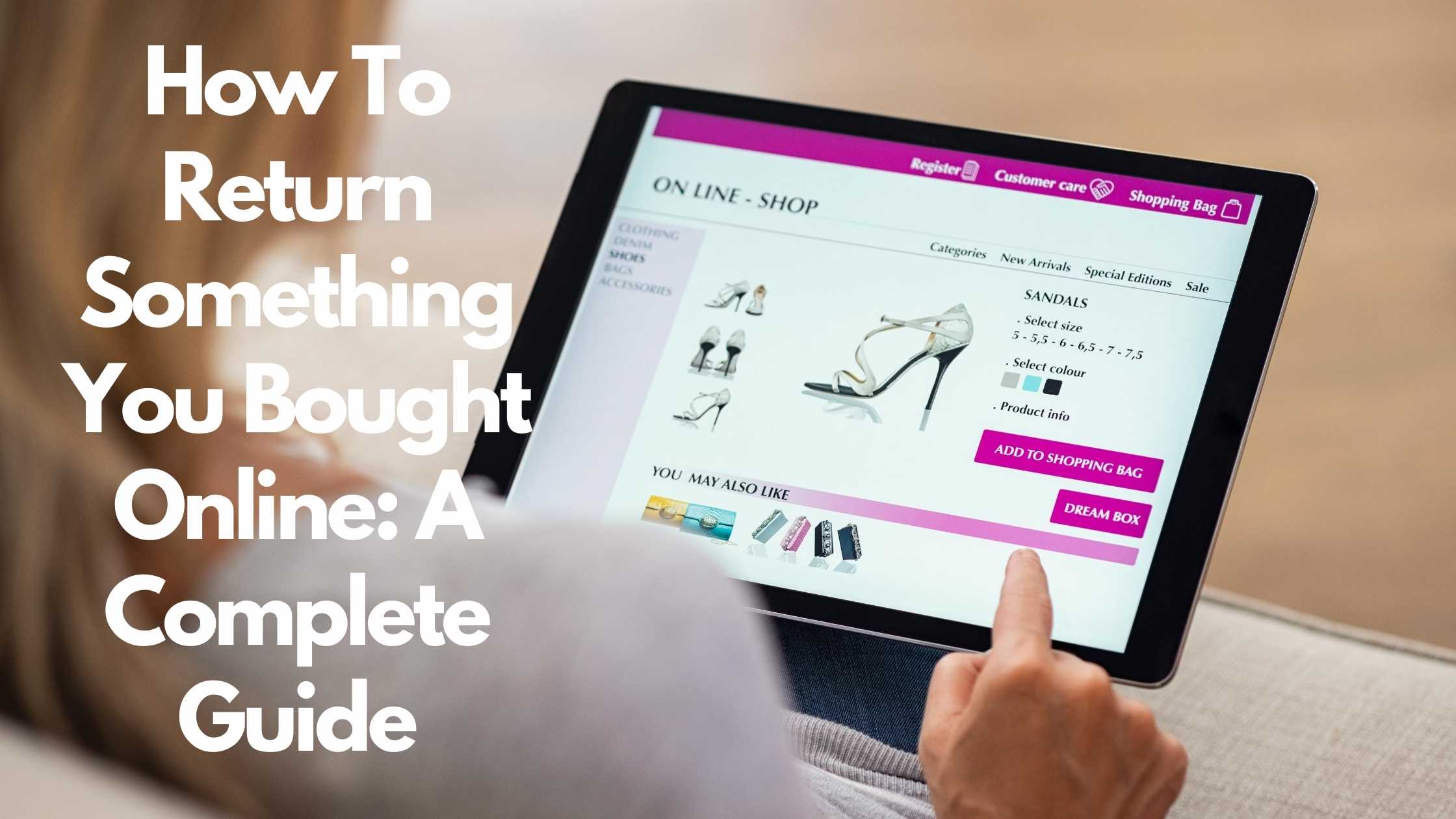
How to Return Something You Bought Online: A Complete Guide

Sometimes, there’s just no way around it: you have to return an item you bought online. Maybe that cute bathing suit just didn’t fit right, the off-brand tablet was a lot lower-quality than it looked, or the porcelain dinnerware set arrived in pieces. Whatever the reason, returns are a fact of life, especially with online purchases.
Returning something you bought online can be as simple as dropping it off at the retailer’s local store. Other businesses make it easy by including a pre-printed label if you need to make a return. But, some returns can be challenging.
If you’re wondering how to go about returning an item, this article will tell you everything you need to know. Keep reading to find out about different types of return policies, problems you might face during the process, and a step-by-step guide for how to return something you bought online.

Step-by-step Guide for Returning Items
Check the Website for Return Policies
Return to the website where you made your purchase. Review their return policy and follow instructions. In many cases, it’s just printing out a return label, repacking the item and sending it back.
Sometimes, you may have to contact the seller for instructions on returning. You may be asked to fill out a contact form or send an email. Still, whenever possible, the quickest way to resolve a situation is to talk to someone directly via phone or live chat.
If you bought the item in question through a third-party site, contact the seller directly. If the seller does not respond or is uncooperative, then contact the third-party company.
In any case, customer service will ask for basic information such as your contact info, order number, and date of purchase.
They may ask you to explain why you are returning the product. Depending on the company and the product in question, you may be offered a refund, an exchange, or credit toward future purchases.
Pack the Item as Close to the Original Packaging as Possible
Repack the item, if possible, in the box it originally came in. If you don’t have the original box, use one of similar size and in good condition. Be sure to include the paperwork containing the order number, if you still have it.
If the item is fragile, take extra care by wrapping it in bubble wrap or filling the box with packing peanuts. Remember, if the returned item is broken, the seller may be hesitant about refunding your money.
Always do your best to make sure the product returns to the company in the best condition possible.
Use Provided Shipping Label or Print a New One
If the company provided a return shipping label, place it in the proper spot on the box. Then, depending on the company’s instructions, either drop it off at the post office or set it out on your porch for pickup.
If a return label and postal pickup are unavailable, create your own label using the company’s address.
Take to Shipping Company
This part can get dicey, although parcel carriers do a great job of working together these days. Pay attention to the service that’s on the label, and make sure you drop the package off at the correct location.

Reasons to Return an Item
There are multiple reasons to return something you bought online. Some of the most common causes include:
You Received the Wrong Item
Sometimes the merchant mistakenly sent you the wrong item or the correct item in the wrong size. This is a very frustrating scenario, which can be worsened if you aren’t sure of the proper way to return the item.
The item Didn’t Match the Description.
It’s quite common to receive a product that doesn’t live up to its description. Perhaps the satin dress you ordered was made of cheap silk, or the sleek blue-and-black road bike turns out to be red. Whatever the discrepancy, this is a common reason for online purchases being returned.
You Received a Damaged Item
This happens more often than you might think. Usually, the damage occurs with rough handling during transit. Still, it could also be due to poor packing or was shipped damaged.
If an item doesn’t work or has missing parts, you should, of course, return it right away, along with a request for a replacement.
The Item Doesn’t Work as Expected or Advertised.
Sometimes, especially with electronic accessories, the item ordered doesn’t work with your specific device. A good example of this would be a faulty or incompatible charging cable, one that is either the wrong type or doesn’t work for your type of device.
You Ordered the Wrong Item
This is an easy mistake to make since all you have to go on is the product description and sometimes a picture or two. Still, a mistake on your end is more likely to result in you paying for the return, which can get expensive.
Always double-check to make sure you’ve selected the right item, the right size, the right style. The more careful you are in selecting what you buy online, the less likely you will make a mistake that results in a costly return.
You Can’t Use a Gifted Item
This frequently happens around the holiday season. You may be given a gift that doesn’t fit, doesn’t work for what it was purchased for, or you simply have no use for. In this case, it may seem like the best option to return the gift.
In this case, the company will most likely exchange the item for a gift card or store credit worth the same amount. If you have the receipt or order number, some companies may agree to exchange the gift for cash, but this is rare if the item was bought online.
You no Longer Need the Item
Perhaps you needed a new phone case and ordered one online. Then your friend bought you one for your birthday. Maybe you like the one your friend gave you the best, so you choose to return the one you ordered online.
If the item is unopened, the return process should be simple. However, some companies may expect you to pay for return shipping. If you have opened or used the product at all, it may be more difficult to return as the company may or may not want to take it back.
Changes in Financial Situation
Situations such as card theft, losing a job, or increasing monthly expenses may make it necessary to return an item you can no longer afford.
Keep in mind; this may not be the best option financially. You may have to pay for the return, which in some cases may be more expensive than the cost of the item in question. The product may not be eligible for a refund if it was purchased a long time ago or if it is used.

Types of Return Policies
Each retailer has its policies and procedures regarding merchandise returns. So it’s a good idea to familiarize yourself with the process before you reach out to the company. Most retailers will accept returns, and those who don’t will likely say so upfront on their website.
Most online sellers accept returns within 30 days of purchase. Some companies will pay for the return, while others will expect you to cover the cost of shipping and handling. According to US Legal, having the customer cover the shipping cost “tends to discourage frivolous returns.”
There are three types of return policies: full refund returns, exchange returns, and store credit returns.
Full Refund
In this type of return, the company will refund you for the entire cost of the returned item. This commonly happens when you, as the buyer, decide you don’t need the item and simply want to get your money back, or when you’re unhappy with the quality of the product, and you plan to buy it elsewhere.
Typically, online sellers will refund your money via whatever payment method you used to make the order. For example, if you used a credit or debit card, the company would refund that card. If you ordered through PayPal, they would refund the money to your PayPal account.
Exchange
Sometimes, companies will offer to exchange the returned item for a replacement. A good example of this type of return is if you received a shirt in the wrong size. It makes the most sense to simply trade the wrong-size shirt for one in the correct size. Exchanges also frequently happen if an item arrives damaged or the seller sent the wrong product.
Most often, the item is simply exchanged for a comparable item–the same shirt in a different size, the same computer without any damage, etc.
Sometimes, if you are simply unhappy with the product you received, the company will allow you to choose a different item of equal or lesser value. Say you ordered a sun hat but didn’t like the color or style. The seller may allow you to return it in exchange for a different style of a sun hat, a ball cap, or a beanie.
Store Credit
In some cases, a company may offer to refund you in the form of credit that can be used toward other purchases within the company. Certain retailers offer this as their only form of a refund, while others will offer a store credit on returns that do not qualify for a cash refund or exchange–for example, if an item is returned used or outside the usual 30-day return window.
Special Circumstances
Generally, it’s easiest to return products that you recently purchased and did not open or use. Most companies will not hesitate to process the return in such cases.
If you want to return a product that you’ve opened or used, it’s best to double-check the company’s return policy. Some companies will not accept returns on used items, products with missing boxes, or clothes without tags.
If you bought online from a local company, you might be able to save money on shipping by returning the item in-store. Companies offering this service are listed in this article. If you’re not sure whether your local store accepts online purchase returns, simply give them a call.
Some larger companies may offer postal pickup on your returns. This convenient service is fairly uncommon, but be sure and check out the company’s return policy to find out if this may be an option for you.
Still, other companies engage a third-party return management service, like this one, to handle all returns. These services use a “reverse logistics” system to manage returns in the most cost-efficient and convenient ways. They act as a liaison between company and customer, creating policies and offering solutions that work best for both sides.
Remember, sellers are not required to allow returns. Most online vendors do offer them because buyers are less likely to buy online if they know they can’t return unsatisfactory products. Again, it’s best to look into the company’s return policy before purchasing anything. If a seller doesn’t allow returns, their website should make this clear upfront.

Problems You Might Encounter
Many shoppers choose not to return items because of the hassle involved. Some of the problems you may run into when trying to return items include:
Returns Considered Suspicious
One problem retailers face with returns is a widespread incidence of customer fraud. In an effort to prevent customer fraud, some businesses have strict return policies and may refuse to process any return that they consider suspicious.
Suppose you try to return a damaged or broken item, for example or have a history of frequent returns with a specific company. In that case, the company may decide whether the return is suspicious and refuse to process it.
Unclear Return Policy
If your purchase was carried out privately or through a small company, the seller might not have established any clear guidelines for returns. In this case, it may be more of a guessing game trying to figure out who to get in touch with and how to return the product.
Company Offers are Unsatisfactory
Some companies may only offer credit toward another purchase rather than a refund or exchange. This can be a very frustrating scenario if you’re unhappy with the company’s service or uninterested in buying any other products from them. This can lead to headaches on both sides of the transaction.
The company Won’t Take the Item Back
In some cases, companies will only accept returns on specific items or under certain circumstances. As this NPR article reports, one company would only process returns for defective items and warranty scenarios; so they refused to accept a return on an item shipped in error.
Companies will generally outline the kinds of returns they will and will not accept. Still, the guidelines are not always clear and may not apply to every situation. Sometimes, your best option is to call and talk to someone who can help you.
Customer Service Won’t Respond
A common problem many buyers face is not hearing back from customer service. Their email may have gotten lost somewhere along the way, the representative may have forgotten to return a phone call, or in rare cases, the company may not care.
Most of the time, not hearing back from customer service is a simple mistake on the seller’s part. Still, from the buyer’s point of view, it is always aggravating and may make the seller seem unprofessional.
Customer Service Takes a Long Time to Respond
Similarly, if the purchase was from a foreign vendor, the return process may take a long time. Customer service may not respond promptly, and it may take time for them to come up with a return plan.
High Return Costs
Some companies and private sellers will expect you to cover the cost of the return. International shipping and fees for heavy, breakable, or perishable items may prove to be quite expensive.

Tips for Handling Return Problems
If you run into problems while returning an online purchase, there are several things you can do to try and make the process run a little bit smoother.
Be Respectful
Try not to let your frustration get the better of you. When speaking with a customer service representative, remember that they’re just people doing their jobs. Even if there isn’t much they can do to help you, most of them are not deliberately trying to ruin your day, so try not to make their job any harder than it is.
Be firm in your expectations, and ask to speak to a manager if necessary. Although, remember that yelling and cursing at a company representative will not accomplish anything.
Be Persistent
If you don’t hear back from the company, call again. Send another email. Keep trying until you get in touch with someone who can help you.
Be Cooperative
Allow the customer service representatives to help you through the process. Ask questions if anything is unclear, but don’t argue. Listen and follow instructions on any forms they give you to fill out, and send the return.
Be Willing to Negotiate
Suppose you’re working with a private seller who has no return policy. In that case, you may be able to negotiate the terms of the return. You won’t get anywhere if the seller refuses to take the item back. If you’re willing to negotiate, you may find a compromise that works for both of you. Maybe the seller will agree to refund your money if you pay for the return shipping, for example.
If you Can’t Return an Item, Sell it Through Sheepbuy
Sometimes, despite your best efforts, a company may refuse to process your return, or you may decide that returning an item isn’t worth the hassle involved. Sheepbuy is a platform that allows you to post items for sale and interact directly with buyers. There are no fees, you can set your prices, and after an item is sold, you receive payment immediately via PayPal.

Tips for Avoiding Return Problems
The best way to avoid problems with returning an online purchase is to avoid having to return the item in the first place. Of course, this is not always possible. You can’t control whether an item you receive is damaged during shipment or is different from the item you ordered. However, there are certain factors you can control.
Know the Return Policy Beforehand.
Before ordering from a company, make sure you’re familiar with their return policy. Most companies will have this information on their website. If you didn’t find a webpage dedicated to returns, or the policy isn’t very clear, it wouldn’t hurt to call or email customer service. Or to choose another seller.
Better to do your research beforehand than to end up with an expensive product you can’t return.
Double-check your Order Before Finalizing
Make sure you are ordering the correct item before confirming the order. Check the product description, the specifications, the size, the item number, the brand, the color, and the condition. All information available to ensure that you’re buying what you intend to purchase.
Again, it isn’t always possible to know that what you see online is what you will receive. But it doesn’t hurt to do everything you can to make sure you’re ordering the right item.
Read Customer Reviews
Scrolling through online reviews should give you a pretty good idea of whether or not a company is trustworthy and professional. A quick google search will yield similar results. Reading reviews is one of the best ways to find out about a company because they reflect other customers’ experiences.
Pay particular attention to reviews that mention how the company has handled past returns or how prompt their customer service is. If a lot of customers complain about a lack of professionalism or rudeness, it might be a good idea to find another seller.
Investigate the Seller Before Buying.
One of the best ways to do this is through customer reviews. You can also lookup a company’s rating on Better Business Bureau or some similar site.
If you’re buying from a small company or private seller through a third-party company like Amazon, Sheepbuy, or eBay, find out as much about the seller as possible. See how long they’ve been in business, what kind of seller rating they have, if they have a website, and if it looks professional.
The more you know about a company or vendor, the better idea you’ll have about whether they are trustworthy and likely to handle returns professionally.
Return the Item as Soon as Possible
Whatever the reason for your return, contact the seller immediately. If you wait, you’re more likely to forget about returning the item, misplace the necessary paperwork, or miss the 30-day return window.
Don’t Make a Habit of Returning Items.
Some people will buy several similar items, choose the one they like best, and return the rest. While this can make up for not being able to handle or try out an item in-store physically, it creates a headache for the seller.
Suppose you start to get a reputation as someone who returns many purchases, this could strain your relationship with your favorite companies and sellers.
What to Expect After the Return
It may take days or weeks for the item to make it back to the company and through their returns system. As soon as it does, if there are no complications with the return, you can expect to receive your refund or exchange.
Again, check the actual retailer’s return policy for a timeframe of when you can expect to see a refund or credit. Some retailers are prompt, but others can take quite some time.
Final Thoughts
The return process can be a hassle, even when everything goes smoothly. Online purchases, take time, and can lead to extra expenses from shipping and handling costs. But returning something you bought online is often necessary, so choosing to buy from companies with the best reputations and return policies can save you a lot of trouble.
Whatever difficulties you may run into, try to be patient. Accept the challenges and understand that it is a part of the process. Do your best to buy products you won’t have to return, and buy from sellers you trust to help you out if you have to return something.
If you act in a respectful and cooperative way, chances are, the company will be willing to work with you and find a satisfactory solution.
Recommended Blog Posts:
Sources Used
TRENDING


Online Arbitrage for Beginners (Step-by-Step Guide)

17 Types of Arbitrage Strategies to Turn a Profit

Is Retail Arbitrage Legal?

How to Turn Textbook Arbitrage into a Business for Profit

How Can You Tell if a Book is a First Edition?

What to Do With Your Jigsaw Puzzle When Finished?


